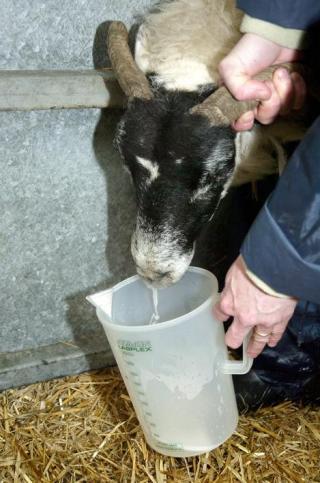Ovine Pulmonary Adenocarcinoma - A Major Animal Health Concern for Scottish Sheep Farming
Published on 26 June 2013 in Sustainability and Communities , Climate, water and energy , Ecosystems and biodiversity , Food, health and wellbeing

Introduction
Ovine Pulmonary Adenocarcinoma (OPA) is an infectious lung cancer in sheep. It is caused by a virus called Jaagsiekte sheep retrovirus (JSRV). OPA is a progressive and invariably fatal disease and is a major problem in sheep farming countries such as Scotland. The clinical signs of OPA in sheep include loss of condition, difficulty breathing, especially when being moved (herded), and the production of a frothy, watery secretion from the nostrils.
It is difficult to assess the true extent of OPA within Scottish flocks because it is not a notifiable disease and is often misdiagnosed. In a study of 125 randomly selected farms in Scotland in 2006-2008, The JSRV infection was observed on 38% of farms, although the observed proportion of individual sheep testing positive was relatively low (3.6%). In affected flocks it is thought that losses due to OPA are generally between 1% and 3% per year, but figures as high as 20% have been reported. This reduction in productivity has major economic implications both for individual farmers and the industry as a whole, especially if valuable breeding rams are affected.
The virus causing OPA can be spread through the air or by contact with respiratory secretions from infected animals and can also be passed to lambs through milk. The disease has a variable incubation period and animals infected with JSRV often appear healthy for a considerable length of time (years) and some never develop disease within their commercial lifespan. There is no reliable diagnostic test for JSRV infection in individual animals before the clinical signs of OPA appear, as neither antibodies to JSRV nor infected cells are present in reliably detectable amounts in the bloodstream of infected sheep. Infected animals may be able to transmit the virus even in the absence of any signs of disease. The virus is therefore easily introduced into new flocks by the addition of infected animals which appear healthy.
There is currently no vaccine against JSRV and no treatment for OPA. The only way to control the disease is through flock management. This involves maintaining a closed flock of disease free animals, removing and culling affected sheep and their lambs, quarantining new additions, and maintaining excellent biosecurity at all times.
Key Points
- Ovine Pulmonary Adenocarcinoma is an infectious lung cancer specific to sheep and caused by Jaagsiekte sheep retrovirus
- The disease is spread mainly through airborne circulation of the virus and by contact with respiratory secretions of infected animals
- OPA is endemic in the UK and widespread across Scotland
- Infected animals often appear healthy for a considerable period before developing clinical disease and some never develop OPA.
- There is no reliable diagnostic test for the early stages of OPA and transmission to closed flocks by the addition of infected but seemingly healthy animals is possible.
- There is no treatment or vaccine for OPA
- Disease control may be achieved through strict flock management practices and good biosecurity
Research Undertaken
Research at Moredun is focused on producing a sensitive and affordable diagnostic test for OPA in order to help identify sheep carrying the disease before clinical signs appear. This would enable the identification of OPA-free flocks from which to source new animals, particularly valuable breeding rams, preventing the introduction of the disease into closed flocks.
Traditionally viral infections are diagnosed testing a blood sample for antibodies to the virus, which are produced by the immune system in an attempt to fight the infection. Most sheep do not produce antibodies to JSRV; however, researchers have identified the presence of anti-JSRV antibodies in a small number of animals and are now trying to determine whether this might be useful in diagnosing OPA.
Examining how the lung tissue of sheep responds to OPA may also help to develop new diagnostic tools. By comparing healthy and diseased lung tissue researchers at Moredun have discovered that certain proteins are much more abundant in the lungs of sheep affected by OPA. More research is needed but scientists hope that these proteins may be used as markers to diagnose OPA in the future. In addition, studies on the host response to JSRV infection is beginning to uncover aspects of the immune response that might be informative for the development of vaccines in the longer term.
Policy Implications
OPA is a common disease in sheep rearing countries, affecting more than one in ten of Scottish flocks. As there is no treatment for OPA, it is a major cause of economic loss for farmers especially when high value breeding rams are affected. Current research is focused on the development of a diagnostic screening test to control the disease and prevent its spread. In the longer term, development of a vaccine will also help to control and prevent the disease. This research will increase farm productivity, reduce the environmental impact of farming and improve animal health and welfare. Ultimately, this will increase the sustainability of sheep farming and promote the viability of rural communities.
Authors
Chris Cousens chris.cousens@moredun.ac.uk
David Griffiths david.griffiths@moredun.ac.uk
Topics
Sustainability and Communities , Climate, water and energy , Ecosystems and biodiversity , Food, health and wellbeing







